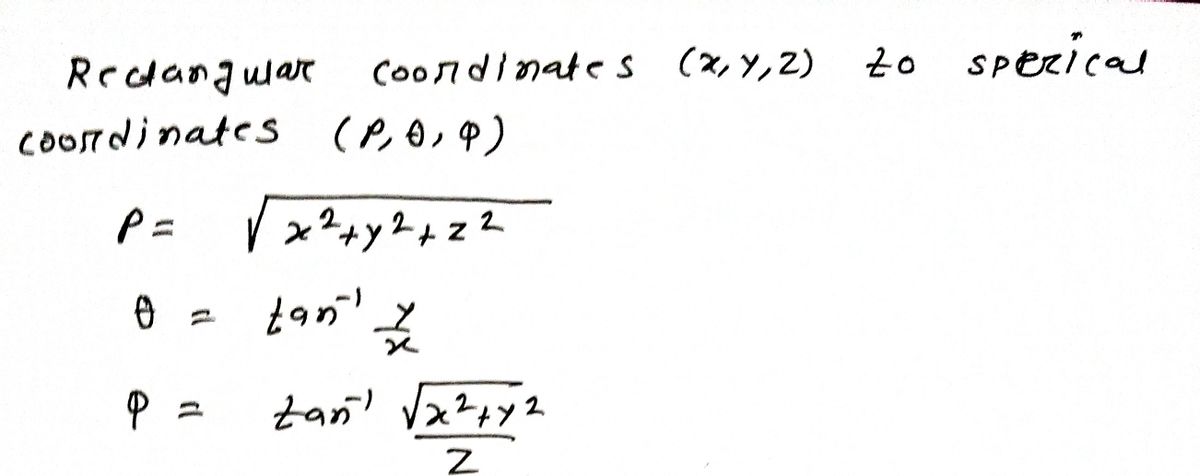Calculus: Early Transcendentals
8th Edition
ISBN:9781285741550
Author:James Stewart
Publisher:James Stewart
Chapter1: Functions And Models
Section: Chapter Questions
Problem 1RCC: (a) What is a function? What are its domain and range? (b) What is the graph of a function? (c) How...
Related questions
Question
![**Converting Rectangular Coordinates to Spherical Coordinates**
In this example, we are given a point in rectangular coordinates:
\[
(5, 5, 9\sqrt{7})
\]
Our goal is to convert this point into spherical coordinates, denoted as \( (\rho, \theta, \phi) \).
### Steps for Conversion:
1. **Determine \(\rho\) (the radial distance):**
\[
\rho = \sqrt{x^2 + y^2 + z^2}
\]
2. **Determine \(\theta\) (the azimuthal angle):**
\[
\theta = \tan^{-1}\left(\frac{y}{x}\right)
\]
3. **Determine \(\phi\) (the polar angle):**
\[
\phi = \cos^{-1}\left(\frac{z}{\rho}\right)
\]
### Provide Solution Here:
To solve, plug in the given rectangular coordinates into the formulas above.
\( (\rho, \theta, \phi) = \left( \boxed{\phantom{a}} \right) \)
**Note:** The red formatting highlights the specific example coordinates we are using in this conversion exercise. To complete the conversion, perform the calculations as per the formulas provided.](/v2/_next/image?url=https%3A%2F%2Fcontent.bartleby.com%2Fqna-images%2Fquestion%2F6ec57636-08bb-40ad-b0ca-9d615e386c7c%2Fa8656381-675d-46a1-94e5-44eb74618551%2Fhtw0uxg_processed.png&w=3840&q=75)
Transcribed Image Text:**Converting Rectangular Coordinates to Spherical Coordinates**
In this example, we are given a point in rectangular coordinates:
\[
(5, 5, 9\sqrt{7})
\]
Our goal is to convert this point into spherical coordinates, denoted as \( (\rho, \theta, \phi) \).
### Steps for Conversion:
1. **Determine \(\rho\) (the radial distance):**
\[
\rho = \sqrt{x^2 + y^2 + z^2}
\]
2. **Determine \(\theta\) (the azimuthal angle):**
\[
\theta = \tan^{-1}\left(\frac{y}{x}\right)
\]
3. **Determine \(\phi\) (the polar angle):**
\[
\phi = \cos^{-1}\left(\frac{z}{\rho}\right)
\]
### Provide Solution Here:
To solve, plug in the given rectangular coordinates into the formulas above.
\( (\rho, \theta, \phi) = \left( \boxed{\phantom{a}} \right) \)
**Note:** The red formatting highlights the specific example coordinates we are using in this conversion exercise. To complete the conversion, perform the calculations as per the formulas provided.
Expert Solution
Step 1

Step by step
Solved in 2 steps with 2 images

Recommended textbooks for you

Calculus: Early Transcendentals
Calculus
ISBN:
9781285741550
Author:
James Stewart
Publisher:
Cengage Learning

Thomas' Calculus (14th Edition)
Calculus
ISBN:
9780134438986
Author:
Joel R. Hass, Christopher E. Heil, Maurice D. Weir
Publisher:
PEARSON

Calculus: Early Transcendentals (3rd Edition)
Calculus
ISBN:
9780134763644
Author:
William L. Briggs, Lyle Cochran, Bernard Gillett, Eric Schulz
Publisher:
PEARSON

Calculus: Early Transcendentals
Calculus
ISBN:
9781285741550
Author:
James Stewart
Publisher:
Cengage Learning

Thomas' Calculus (14th Edition)
Calculus
ISBN:
9780134438986
Author:
Joel R. Hass, Christopher E. Heil, Maurice D. Weir
Publisher:
PEARSON

Calculus: Early Transcendentals (3rd Edition)
Calculus
ISBN:
9780134763644
Author:
William L. Briggs, Lyle Cochran, Bernard Gillett, Eric Schulz
Publisher:
PEARSON

Calculus: Early Transcendentals
Calculus
ISBN:
9781319050740
Author:
Jon Rogawski, Colin Adams, Robert Franzosa
Publisher:
W. H. Freeman


Calculus: Early Transcendental Functions
Calculus
ISBN:
9781337552516
Author:
Ron Larson, Bruce H. Edwards
Publisher:
Cengage Learning